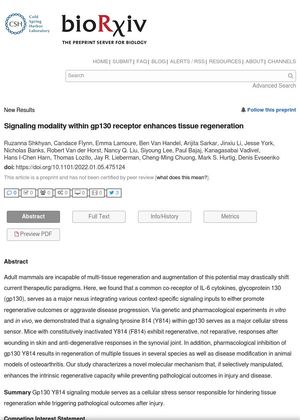Signaling Modality Within GP130 Receptor Enhances Tissue Regeneration
January 2022
in “
bioRxiv (Cold Spring Harbor Laboratory)
”

TLDR The gp130 receptor helps in tissue regeneration and disease progression, and manipulating it could improve healing and prevent disease.
The study "Signaling modality within gp130 receptor enhances tissue regeneration" discovered that the glycoprotein 130 (gp130), a common co-receptor of IL-6 cytokines, plays a crucial role in tissue regeneration and disease progression. The researchers found that a signaling tyrosine 814 (Y814) within gp130 acts as a major cellular stress sensor. In experiments with mice, those with inactivated Y814 showed regenerative responses after skin wounding and anti-degenerative responses in the synovial joint. Furthermore, pharmacological inhibition of gp130 Y814 led to the regeneration of multiple tissues in several species and disease modification in animal models of osteoarthritis. This suggests that selective manipulation of this molecular mechanism could enhance intrinsic regenerative capacity while preventing pathological outcomes in injury and disease.
